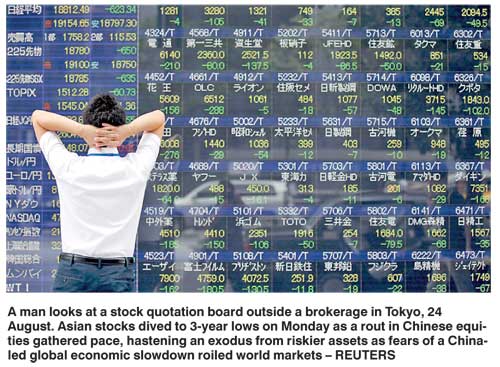Saturday Mar 15, 2025
Saturday Mar 15, 2025
Tuesday, 25 August 2015 00:54 - - {{hitsCtrl.values.hits}}
SINGAPORE (Reuters): Commodities markets tumbled on Monday as fears spread that a more severe slowdown in China would pull down other economies in the region, denting energy and raw material consumption.
Chinese stocks dived more than 8% on Monday morning, with the Shanghai index giving up all its gains for the year, prompting a broader sell-off in riskier assets, including oil and metals.
“Stock markets are often said to be leading indicators of the global economy. Given how equity markets have slumped in the past  couple of weeks and months, it may be an ominous foreboding of things to come,” Singapore-based Phillip Futures said.
couple of weeks and months, it may be an ominous foreboding of things to come,” Singapore-based Phillip Futures said.
In oil markets, the US West Texas Intermediate (WTI) and Brent marked fresh six-year lows, falling to levels last seen during the peak credit crunch of 2009.
WTI traded well below $ 40 a barrel and Brent fell under $ 45 per barrel by 0500 GMT. With prices down 60% from 2014 highs, revenues for oil exporting countries are being hammered.
“The continued fall in oil prices and uncertainty about China’s growth prospects have added further downside risks to Saudi Arabia’s macroeconomic outlook,” Barclays said about the world’s top crude exporter, which has been forced to issue bonds and eat into its foreign reserves to cover a huge budget deficit.
In coal, the most common source for electricity generation, API2 2016 futures already hit 12-year lows last week, and physical prices for cargoes from Australia’s Newcastle or South Africa’s Richards Bay terminals are back to levels last seen before the 2008/2009 boom and bust.
Analysts said further downward price adjustment might come.
“Global investor sentiment dipped in August to the lowest level since we started the survey,” Morgan Stanley said, adding that an adjustment process would be long and painful.
In metals, copper and aluminium futures hit 2009 lows on Monday, while iron ore and steel futures in China slid sharply to reach their downside limit.
Australia’s Fortescue Metals Group said its annual profit slumped 90%, the latest iron ore miner to report sharply lower earnings on weak prices for the steelmaking ingredient as China’s economy slows.
The rout has also spread to sectors that have so far been performing well. The MAC global solar index, which soared in early 2015, has almost halved in value since April, pulled down by the tumbling Chinese stock markets.
India tries to calm jittery investors as markets tumble
India’s policymakers tried to soothe jittery investors on Monday after domestic shares slid nearly 6% and the rupee sank to its lowest since late 2013 following a China-led sell-off across Asia. |
China gives pension funds access to stock market
China on Sunday allowed pension funds managed by local governments to invest in the stock market for the first time, potentially channelling hundreds of billions of yuan into the country’s struggling equity market. |
Discover Kapruka, the leading online shopping platform in Sri Lanka, where you can conveniently send Gifts and Flowers to your loved ones for any event including Valentine ’s Day. Explore a wide range of popular Shopping Categories on Kapruka, including Toys, Groceries, Electronics, Birthday Cakes, Fruits, Chocolates, Flower Bouquets, Clothing, Watches, Lingerie, Gift Sets and Jewellery. Also if you’re interested in selling with Kapruka, Partner Central by Kapruka is the best solution to start with. Moreover, through Kapruka Global Shop, you can also enjoy the convenience of purchasing products from renowned platforms like Amazon and eBay and have them delivered to Sri Lanka.
Discover Kapruka, the leading online shopping platform in Sri Lanka, where you can conveniently send Gifts and Flowers to your loved ones for any event including Valentine ’s Day. Explore a wide range of popular Shopping Categories on Kapruka, including Toys, Groceries, Electronics, Birthday Cakes, Fruits, Chocolates, Flower Bouquets, Clothing, Watches, Lingerie, Gift Sets and Jewellery. Also if you’re interested in selling with Kapruka, Partner Central by Kapruka is the best solution to start with. Moreover, through Kapruka Global Shop, you can also enjoy the convenience of purchasing products from renowned platforms like Amazon and eBay and have them delivered to Sri Lanka.